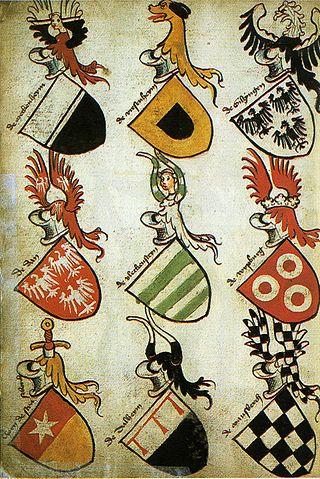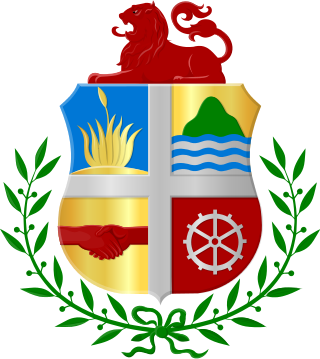
Heraldry is a discipline relating to the design, display and study of armorial bearings, as well as related disciplines, such as vexillology, together with the study of ceremony, rank and pedigree. Armory, the best-known branch of heraldry, concerns the design and transmission of the heraldic achievement. The achievement, or armorial bearings usually includes a coat of arms on a shield, helmet and crest, together with any accompanying devices, such as supporters, badges, heraldic banners and mottoes.

The Coat of arms of Aruba has been officially in use since November 15, 1955, as the recognized national symbol of Aruba.

A roll of arms is a collection of coats of arms, usually consisting of rows of painted pictures of shields, each shield accompanied by the name of the person bearing the arms.

The Heraldry Society is a British organization that is devoted to studying and promoting heraldry and related subjects. In 1947, a twenty-year-old John Brooke-Little founded the Society of Heraldic Antiquaries. This name was changed to The Heraldry Society in 1950. It was incorporated in 1956 and is now a registered educational charity, with the registered charity number 241456.

D'Arcy Jonathan Dacre Boulton is a Canadian medieval historian, and heraldic author and artist. He is descendant of Boulton family of Toronto.

Johannes Baptista Rietstap was a Dutch heraldist and genealogist. He is most well known for his publication of the Armorial Général. This monumental work contains the blazons of the coats of arms of more than 130,000 European families. It is still one of the most complete works of its kind.

Heraldry in the United States was first established by European settlers who brought with them the heraldic customs of their respective countries of origin. As the use of coats of arms may be seen as a custom of royalty and nobility, it had been debated whether the use of arms is reconcilable with American republican traditions. Families from English, Scottish, Irish, Welsh, German, and other European nations with a heraldic tradition have retained their familial coat of arms in the United States. Several founding fathers also employed personal arms and a great number of Americans continue to do so.
Carl-Alexander von Volborth was a German-born fine artist and American heraldic artist and heraldist.
Danish heraldry has its roots in medieval times when coats of arms first appeared in Europe. Danish heraldry is a branch of the German-Nordic heraldic tradition.

Burgher arms or bourgeois arms are coats of arms borne by persons of the burgher social class of Europe since the Middle Ages. By definition, however, the term is alien to British heraldry, which follows other rules.

The coat of arms of the Crown of Aragon bears four red pallets on a gold background, and it depicts the familiar coat of the Kings of Aragon. It differs from the flag because this latter instead uses bars. It is one of the oldest coats of arms in Europe dating back to a seal of Raymond Berengar IV, Count of Barcelona and Prince of Aragon, from 1150.
Ottfried Neubecker was a German vexillologist and heraldist.
Sven Tito Achen was an Argentine-Danish writer and author on heraldry, co-founder of the Scandinavian Society of Heraldry and the first editor of the Scandinavian Heraldisk Tidsskrift published in Denmark.

Norwegian Heraldry Society is a heraldry society located in Oslo, Norway, which was founded in 1969.
A heraldic authority is defined as an office or institution which has been established by a reigning monarch or a government to deal with heraldry in the country concerned. It does not include private societies or enterprises which design and/or register coats of arms. Over the centuries, many countries have established heraldic authorities, and several still flourish today.
Anthony Wood, FSHA, FSSI was a British heraldic artist and a master of heraldry.

The Macedonian Heraldic Society (MHS) is the only professional body in the field of heraldry, vexillology, phaleristics, chivalristics and nobiliar issues in North Macedonia. The society was founded on 2 July 2003 in Skopje under the name Macedonian Heraldry Society, and changed to its current name in 2018.

The armorial of British universities is the collection of coats of arms of universities in the United Kingdom. Modern arms of universities began appearing in England around the middle of the 15th century, with Oxford's being possibly the oldest university arms in the world, being adopted around the end of the 14th century. The earliest granting of university arms was to King's College Cambridge by Henry VI in 1449. Arms are granted by the College of Arms and Lyon Court. It has been suggested that new universities register arms in an attempt to appear more traditional or legitimate. As corporations, older university arms have historically been granted without a crest, however newer institutions use crests with mantling, including new colleges at older universities. The first crest granted to a university was to Leeds in 1905 while the first British university to be granted supporters was Sussex in 1962, although both Oxford and Cambridge have used angels as supporters and Cambridge has used the 'alma mater' emblem as a crest without these components being officially granted.

The Council of Heraldry and Vexillology is the Heraldic authority for the French-speaking Community of Belgium. It is the institution that advises the Government of the French-speaking Community on all matters concerning civic, personal, and familial arms and flags. Grants of arms from the Council are published in the Belgian official journal.

Belgian heraldry is the form of coats of arms and other heraldic bearings and insignia used in the Kingdom of Belgium and the Belgian colonial empire but also in the historical territories that make up modern-day Belgium. Today, coats of arms in Belgium are regulated and granted by different bodies depending on the nature, status, and location of the armiger.
















